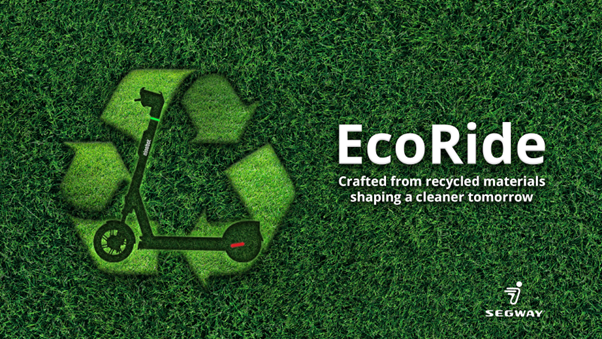Last year, Segway was awarded its first-ever Life Cycle Assessment (LCA) award after the leading international testing and certification organisation TÜV SÜD conducted an evaluation into its environmental impact.
Segway was already striving to increase its reliance on recycled materials even before receiving the award. However, the LCA has enabled the company to further understand the biggest contributor to carbon emissions, and the evaluation has encouraged Segway to continue its commitment to recycled materials.
“As a leading vehicle and solution provider, Segway is committed to reducing the environmental impact of shared micromobility,” Yao Yao, Strategic Product Manager of Commercial Mobility Business Division at Segway-Ninebot, tells Zag Daily.
“To achieve this, Segway has cooperated with TÜV SÜD to identify and implement targeted improvements across the product life cycles. The life cycle assessment fosters resource efficiency, reduces environmental impact, and strategically aligns with our sustainability goals.”
During the assessment process, TÜV SÜD evaluated the environmental impact of Segway’s S90L and Max Plus X electric scooter models. 18 environmental impact categories were measured including global warming impact, ozone depletion and fossil resource scarcity.
With a focus on the electric scooter’s global warming impact, one lifecycle stage was found to be a particular contributor to the result.
The Raw Material Stage
Segway has been measuring the environmental impact of the raw material stage for years, but the LCA certainly highlighted its impact and this stage was found to be the greatest contributor to the global warming impact category.
“The carbon footprint associated with raw material extraction and processing depends on various factors such as the type of raw materials, the extraction methods, the energy sources used in the processes and others.”
In particular, aluminium alloy structural components are the most significant contributors at the raw material stage, amounting to 36.91% to 38.90% of the total product life cycle assessment value contribution to global warming.
Segway’s response
In a continuous commitment to reducing emissions and prioritising sustainability, Segway is seeking greener and lower-carbon alternatives for its raw materials and components, specifically for its metal and plastic components.
“Segway’s strategies have a specific focus on metal and plastic.”
Segway has utilised recycled metal for approximately 41% of a recent vehicle’s total metal weight. It is also in the planning stages to extend the use of recycled metal into all shared e-scooter models.
In undergoing a thorough series of tests and comparisons to reach certain qualifications, Segway has proved that the functionality, quality, and performance of models incorporated with recycled materials matches that when non-recycled materials were used.
Plastic is another focus for the company, and it’s striving to use various recycled plastics including Polycarbonate & Acrylonitrile Butadiene Styrene, Polypropylene, and others in its models and spare parts.
Segway has already incorporated a milestone of 51% of recycled plastics into the total plastic weight of a vehicle, and it’s working to incorporate recycled plastics into all of its shared e-scooters.
“The use of recycled plastics in shared e-scooters reduces demand for virgin plastic and minimises environmental impact.
“Segway’s commitment to environmental responsibility serves as an inspiration for other companies in the industry to address climate change and collaborate towards collective climate action,” Yao Yao says.

Segway’s attention to recycled materials also aims to meet the United Nations’ 17 Sustainable Development Goals (SDGs). In its commitment to making micromobility greener, it wants to help its clients understand the environmental impact of the vehicles they have bought and support them in becoming carbon-neutral to reduce carbon emissions in the production process.
“Our continuous efforts to diminish carbon emissions span every phase of the manufacturing process, highlighting the efficient use of recycled materials and advocating for recycling programmes to promote environmentally friendly products.
“By sharing this valuable information with operators and cities, our goal is to enhance the industry’s understanding of the life cycle impact of micromobility vehicles and services.
“This strategy reflects our vision for a greener tomorrow and mission to provide innovative micromobility products and solutions that redefine the way we move in urban cities.”





